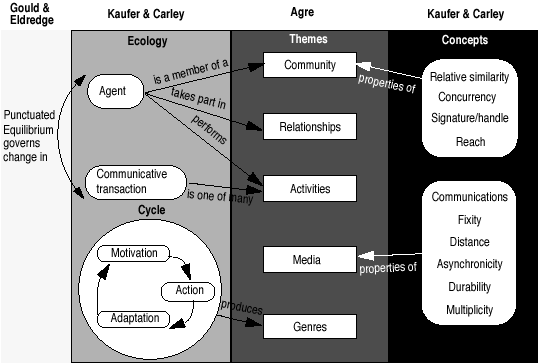Hypermedia Online Publishing: the Transformation of the Scholarly Journal
2.6 Conclusion
The theoretical perspectives chosen are directly relevant to the question of transformations within the scholarly journal. It is important to realise that the three main bodies of theory operate on three different, but related, levels. The first, a constructuralist ecology of communication, addresses the overall environment in which scholarly communication takes place and which scholarly journals 'inhabit'. The second, punctuated equilibrium, addresses the ways in which changes might take place within such an ecology. The third, a genre-based framework for new media, addresses the task of designing a new 'species' of journal to inhabit such a changed ecology.
The work of Kaufer and Carley provides a range of precisely defined characteristics of the communication process that can be examined in the context of hypermedia scholarly journals. Their idea of an evolving open systems ecology is an extraordinarily powerful way to think about the interactions with the evolving field of electronic scholarly publishing.They also provide a number of specific suggestions with respect to new communication technologies that will need to be considered in the light of the possibilities inherent in those technologies.
Gould and Eldredge's model of punctuated equilibrium change in species builds on the idea of the communications ecology to analyse the processes of change and make predictions about both the rate of change and ability to predict developments from known starting points.
Agre's theoretical perspective provides a very useful way to think about some of the key components in the ecology that surrounds hypermedia scholarly journals. The notions of community, activity, relationship, medium and genre are all very powerful ways of conceptualising what happens when we use a journal..
Figure 2-3 shows the linkages between these three theoretical perspectives. The concepts of agent and communicative transaction from Kaufer & Carley's ecology of the communicative transaction are both linked to Agre's perspectives. An agent is a member of (at least one) community, takes part in relationships with members of that community, and performs activities (both within the community and outside it). The communicative transaction is one of those activities. Kaufer and Carley's concepts of relative similarity and concurrency are both properties of the community. The members of the community also have particular mental models, signatures, and reach. Communications, fixity, distance, asynchronicity, durability and multiplicity are all properties of the medium of communication. Kaufer and Carley's communicative transaction cycle produces (among other things) during its process of evolution Agre's genres. Finally, Gould & Eldredge's augmentation of the theory of evolution with their mechanism of punctuated equilibrium governs the processes of change within the ecology. Thus the three perspectives complement and inform each other. Each has its own concerns, but links powerfully to the other. Together, they provide a rich base for this thesis
Last modified: Monday, 11-Dec-2017 14:40:59 AEDT
© Andrew Treloar, 2001. * http://andrew.treloar.net/ * andrew.treloar@gmail.com
